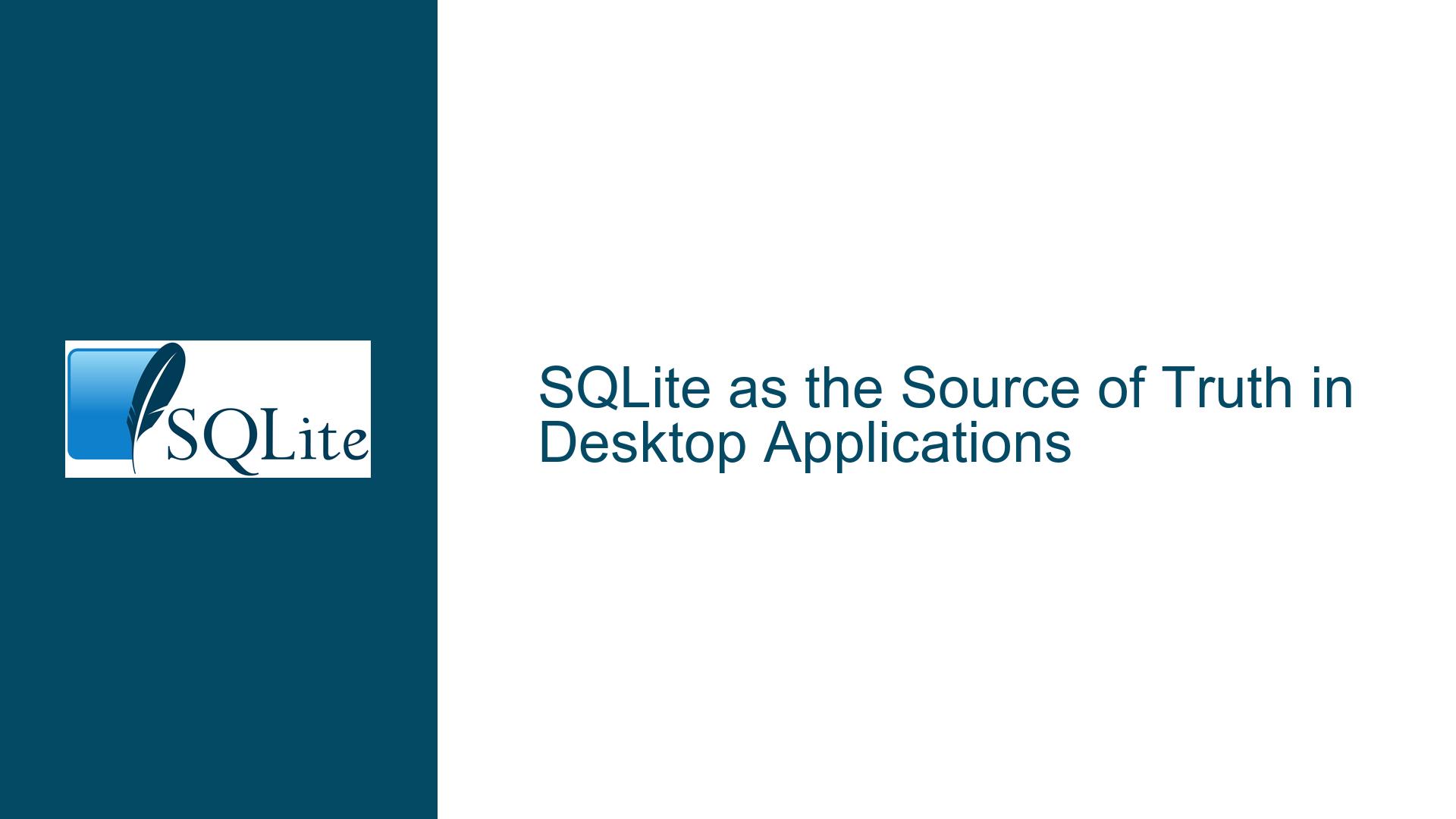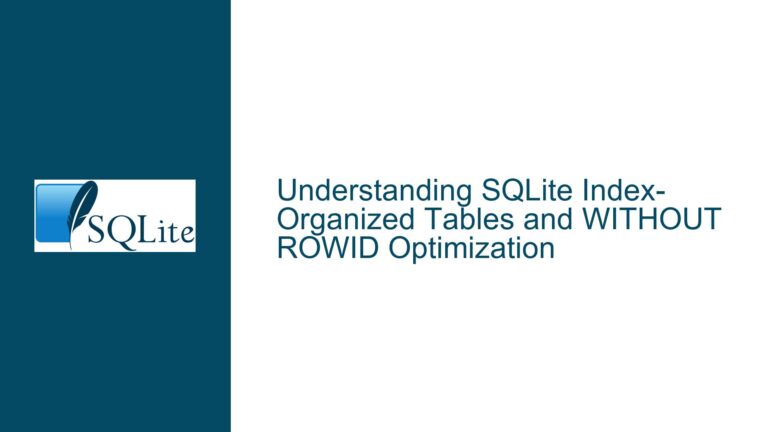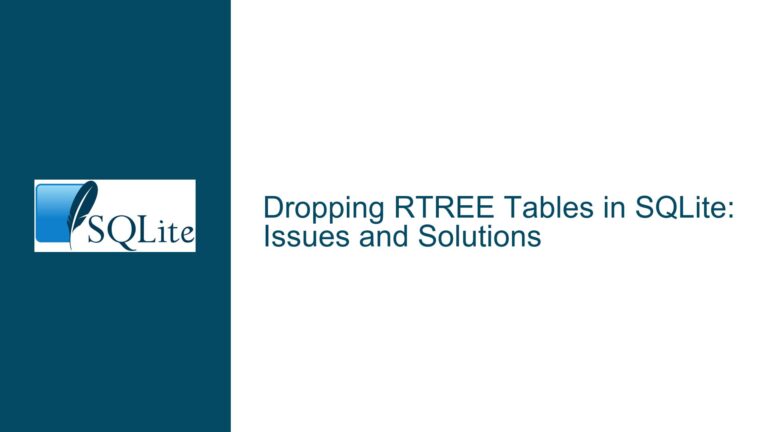SQLite as the Source of Truth in Desktop Applications
Overview of SQLite-Oriented Programming
The discussion surrounding SQLite-oriented programming centers on the concept of utilizing SQLite as the primary data management system for desktop and mobile applications. This approach differs from traditional programming paradigms where data structures like vectors, hash maps, and lists dominate the state management. Instead, SQLite serves as the "source of truth," providing a centralized database that simplifies data handling and enhances application performance.
In this context, the user poses a critical inquiry: are there established programming styles or literature that advocate for using SQLite in this manner? The user aims to understand how to structure an application around SQLite, particularly in a Model-View-Controller (MVC) architecture where SQL queries directly inform the view and control components. This framework allows for real-time interactions, leveraging modern hardware capabilities to execute complex queries efficiently.
The conversation highlights several key points:
MVC Architecture: The proposal suggests that in an MVC setup, the model would consist solely of SQLite databases. The view would render data based on SQL queries, while user inputs (mouse and keyboard events) would translate into SQL commands. This architecture promotes a clean separation of concerns and facilitates easier debugging.
Performance Considerations: The discussion emphasizes that with modern CPUs, the performance of SQLite can meet the demands of real-time applications. Queries can be executed swiftly enough to provide immediate feedback to users, making it suitable for interactive software such as text editors or integrated development environments (IDEs).
Challenges with Traditional Structures: The user expresses frustration with conventional programming practices that scatter state across various data structures, leading to complicated debugging processes. By centralizing state within tables managed by SQLite, developers can simplify access and manipulation of application data.
Existing Implementations: Richard Hipp mentions Fossil, a forum software that exemplifies SQLite-oriented programming by using an SQLite database as its core data store. However, the user seeks examples beyond CRUD applications—specifically targeting low-latency interactive software.
Scripting and Extensibility: A significant advantage of using SQLite as a source of truth is the ease of scripting and extending functionality through SQL queries. This could streamline development processes and enhance application adaptability.
The conversation also touches upon potential misconceptions regarding latency in forum software versus interactive applications. While forum applications may tolerate delays, interactive applications require responsiveness that approaches real-time performance.
In summary, the exploration of SQLite-oriented programming reveals a growing interest in leveraging relational databases as fundamental components of application architecture. By embracing this paradigm shift, developers can create more efficient and maintainable applications that prioritize data integrity and accessibility through SQL-centric designs.
Performance Issues with SQLite as a Source of Truth
When utilizing SQLite as the primary data management system in applications, several performance issues can arise that may hinder the effectiveness of this approach. Understanding these potential pitfalls is essential for developers aiming to leverage SQLite as a source of truth, particularly in high-demand scenarios such as interactive desktop applications or real-time data processing systems.
Concurrency Limitations
SQLite operates under a serverless architecture, which simplifies deployment and reduces overhead. However, this design introduces significant limitations regarding concurrency. SQLite allows multiple concurrent read operations but only permits a single write operation at any given time. This characteristic can lead to performance bottlenecks when applications require frequent write access, as write transactions must queue up behind one another.
In environments with high write demands, such as collaborative applications where multiple users may attempt to update data simultaneously, this single global write lock can become a critical point of contention. The result is increased latency and potential delays in user interactions, ultimately degrading the application’s responsiveness.
Query Optimization Challenges
Another common issue stems from the need for effective query optimization. While SQLite is capable of executing complex queries efficiently, poorly structured SQL statements can lead to significant performance degradation. For example, if queries are not optimized to retrieve only necessary columns and rows, the application may incur unnecessary overhead due to excessive data retrieval.
Furthermore, the absence of appropriate indexing can severely impact query performance. Without indexes on frequently queried columns, SQLite must perform full table scans to locate the required data, which can be time-consuming for large datasets. Developers should ensure that indexes are strategically implemented on columns used in WHERE clauses or JOIN operations to facilitate faster lookups.
Write Performance and Transaction Management
The way transactions are managed in SQLite also plays a crucial role in performance. By default, SQLite uses rollback journaling for transactions, which involves multiple disk writes and can introduce latency during commit operations. For applications requiring low-latency writes, enabling Write-Ahead Logging (WAL) mode can significantly improve performance by allowing concurrent reads and writes while reducing the overhead associated with traditional journaling.
Additionally, grouping multiple write operations into a single transaction can lead to substantial performance gains. Each individual commit incurs overhead; thus, batching updates minimizes this cost and enhances overall throughput.
Memory Management and Resource Utilization
Effective memory management is vital for optimizing SQLite performance. As applications scale and handle larger datasets, ensuring that SQLite utilizes system memory efficiently becomes increasingly important. Developers should monitor memory usage and adjust cache sizes appropriately to prevent excessive disk I/O operations that could slow down query execution.
Moreover, utilizing in-memory databases or caching mechanisms can enhance performance by reducing reliance on disk storage for frequently accessed data. However, developers must balance these strategies with considerations for data durability and consistency.
Schema Design Considerations
The design of the database schema itself can have profound implications on performance. A well-structured schema that adheres to normalization principles can streamline data access patterns and improve query execution times. Conversely, a poorly designed schema may lead to redundant data storage and inefficient querying practices.
Developers should also consider using composite indexes for tables with multiple columns frequently queried together. This approach can significantly reduce query execution times by allowing SQLite to quickly locate relevant rows without scanning through unnecessary data.
Conclusion
While SQLite offers numerous advantages as an embedded database solution, it is essential for developers to be aware of its limitations and potential performance issues when using it as the source of truth in applications. By addressing concurrency constraints, optimizing queries and transactions, managing memory effectively, and designing efficient schemas, developers can enhance the performance of their applications significantly. Understanding these factors will empower developers to leverage SQLite’s capabilities fully while mitigating common pitfalls associated with its use in high-demand environments.
Troubleshooting and Optimizing SQLite for Performance
To effectively troubleshoot and optimize SQLite when using it as a source of truth in applications, several strategies can be employed to enhance performance and mitigate common issues. This section outlines key techniques that developers can implement to ensure that their SQLite databases operate efficiently, particularly in scenarios with high read and write demands.
Enable Write-Ahead Logging (WAL)
One of the most impactful optimizations for SQLite is enabling Write-Ahead Logging (WAL). In WAL mode, changes are first written to a log file before being committed to the main database. This approach allows multiple readers to access the database while a writer is updating it, significantly improving concurrency. To enable WAL mode, execute the following command:
PRAGMA journal_mode = WAL;
Additionally, adjusting the synchronous mode to NORMAL can further reduce transaction overhead by allowing commits to return before data is fully flushed to disk. This setting can dramatically decrease the time taken for each transaction, making the application feel more responsive.
Optimize Transactions
Managing transactions efficiently is crucial for maintaining performance in SQLite. Developers should aim to keep transactions short and avoid long-running operations that can hold locks for extended periods. Instead of committing after every single operation, batch multiple operations into a single transaction. For example:
BEGIN TRANSACTION;
INSERT INTO table_name (column1) VALUES (value1);
INSERT INTO table_name (column1) VALUES (value2);
COMMIT;
This method minimizes disk I/O operations and enhances throughput by reducing the number of commits required.
Use Prepared Statements
Prepared statements can significantly boost performance when executing repetitive queries. By preparing a statement once and executing it multiple times with different parameters, you can reduce parsing overhead. For instance:
PREPARE stmt FROM 'INSERT INTO table_name (column1) VALUES (?)';
EXECUTE stmt USING value1;
EXECUTE stmt USING value2;
DEALLOCATE PREPARE stmt;
This technique not only speeds up execution but also enhances security by preventing SQL injection attacks.
Efficient Indexing
Indexes are critical for speeding up query execution in SQLite. Developers should create indexes on columns frequently used in WHERE clauses or JOIN conditions. However, it is essential to strike a balance; over-indexing can lead to increased maintenance overhead during write operations. A well-planned indexing strategy might include:
- Single-column indexes on highly queried fields.
- Composite indexes on columns that are often queried together.
For example:
CREATE INDEX idx_column1 ON table_name(column1);
CREATE INDEX idx_composite ON table_name(column1, column2);
Regularly analyzing query performance using EXPLAIN QUERY PLAN will help identify whether indexes are being utilized effectively.
Manage Concurrency with Error Handling
Concurrency issues are common when multiple processes attempt to access the database simultaneously. To handle these situations gracefully, developers should implement error handling mechanisms for SQLITE_BUSY errors. Setting a busy timeout allows SQLite to wait for a specified duration before returning an error when the database is locked:
PRAGMA busy_timeout = 5000; -- Wait for 5 seconds before returning SQLITE_BUSY
Alternatively, using a busy handler callback function can provide more control over how your application responds to busy errors.
Optimize Query Design
Writing efficient SQL queries is vital for performance optimization. Developers should focus on retrieving only necessary data by specifying exact columns instead of using SELECT *. Additionally, incorporating filtering conditions early in the query can reduce the amount of data processed:
SELECT column1, column2 FROM table_name WHERE condition;
Avoiding complex joins and subqueries when possible will also contribute to faster query execution.
Memory Management
Proper memory management is essential for ensuring that SQLite operates efficiently. Developers should configure cache sizes appropriately using:
PRAGMA cache_size = 10000; -- Set cache size to 10MB
Monitoring memory usage during application runtime will help identify potential bottlenecks caused by excessive disk I/O due to insufficient caching.
Regular Database Maintenance
Regular maintenance tasks such as vacuuming the database can help reclaim unused space and optimize performance. The VACUUM command rebuilds the database file, eliminating fragmentation and improving read/write speeds:
VACUUM;
Additionally, periodically running ANALYZE will update statistics used by the query planner to optimize query execution plans effectively.
Conclusion
By implementing these troubleshooting techniques and optimizations, developers can enhance the performance of their SQLite databases significantly. Enabling WAL mode, optimizing transactions, utilizing prepared statements, managing concurrency effectively, designing efficient queries, and maintaining proper memory management practices will collectively contribute to a robust and responsive application environment. Regular monitoring and adjustments based on application usage patterns will ensure that SQLite continues to meet performance expectations as demands evolve.






